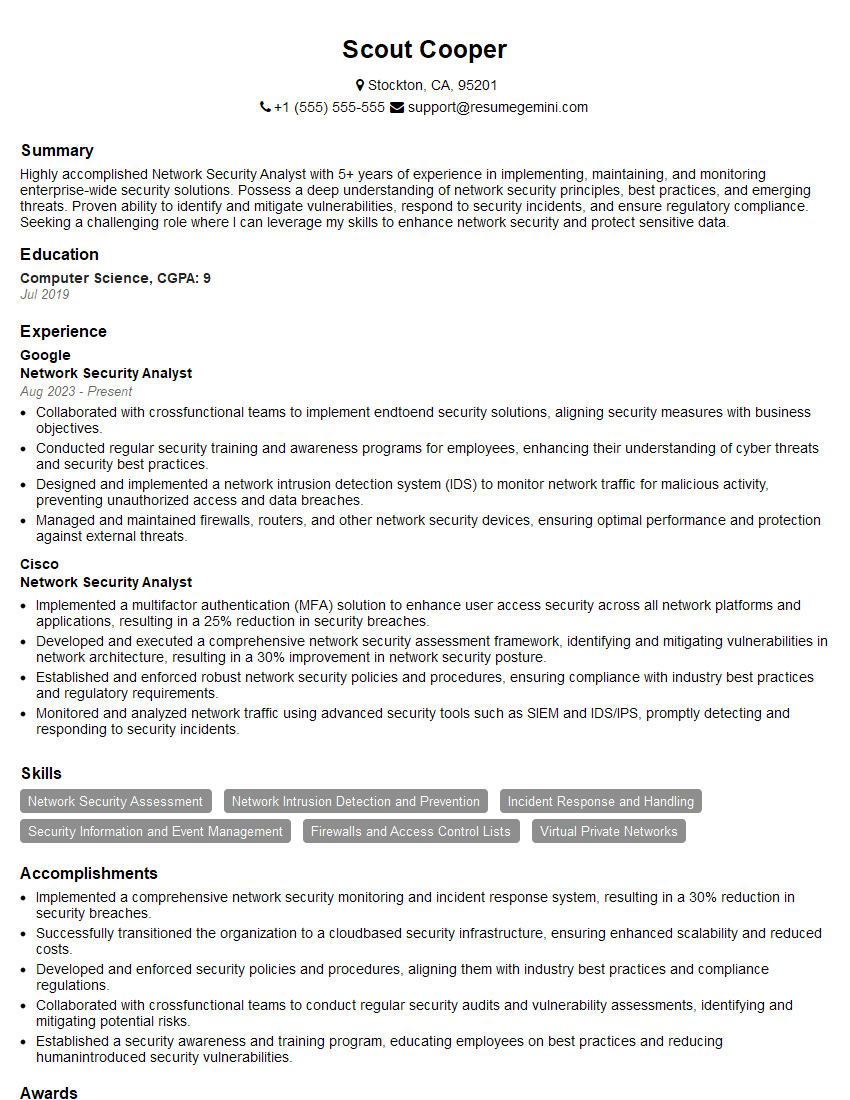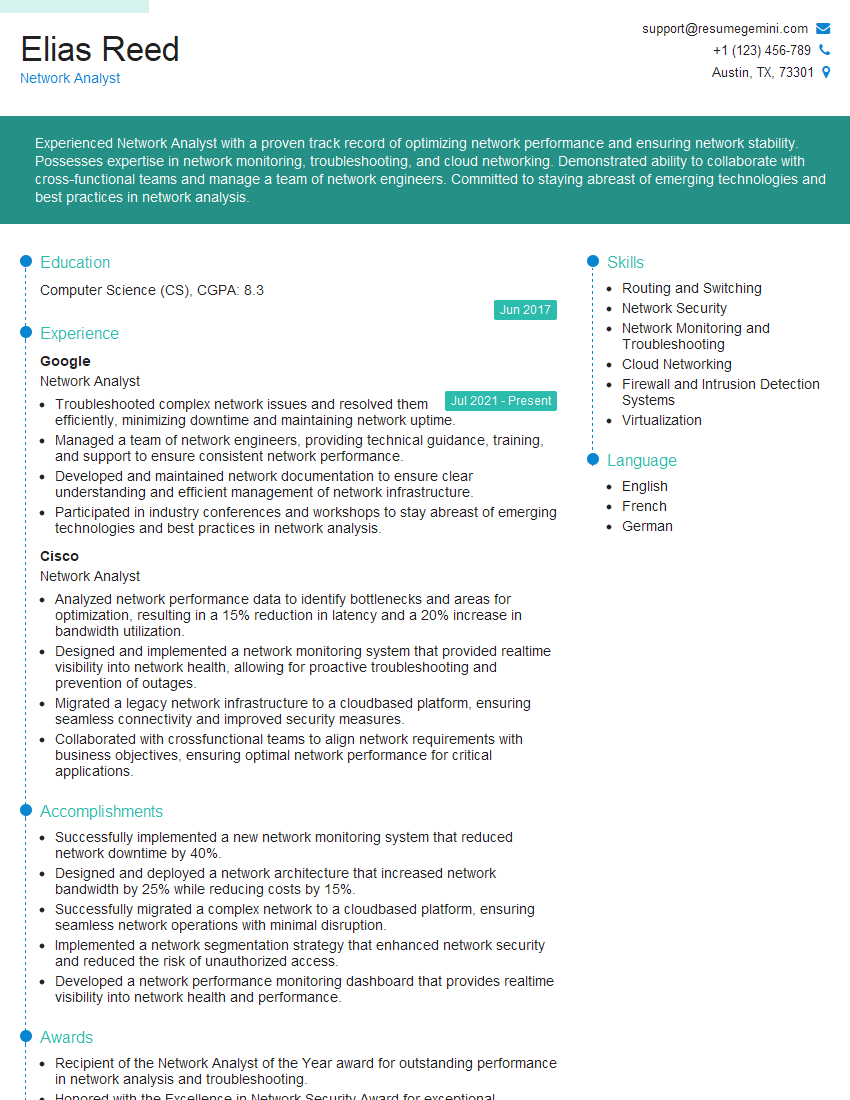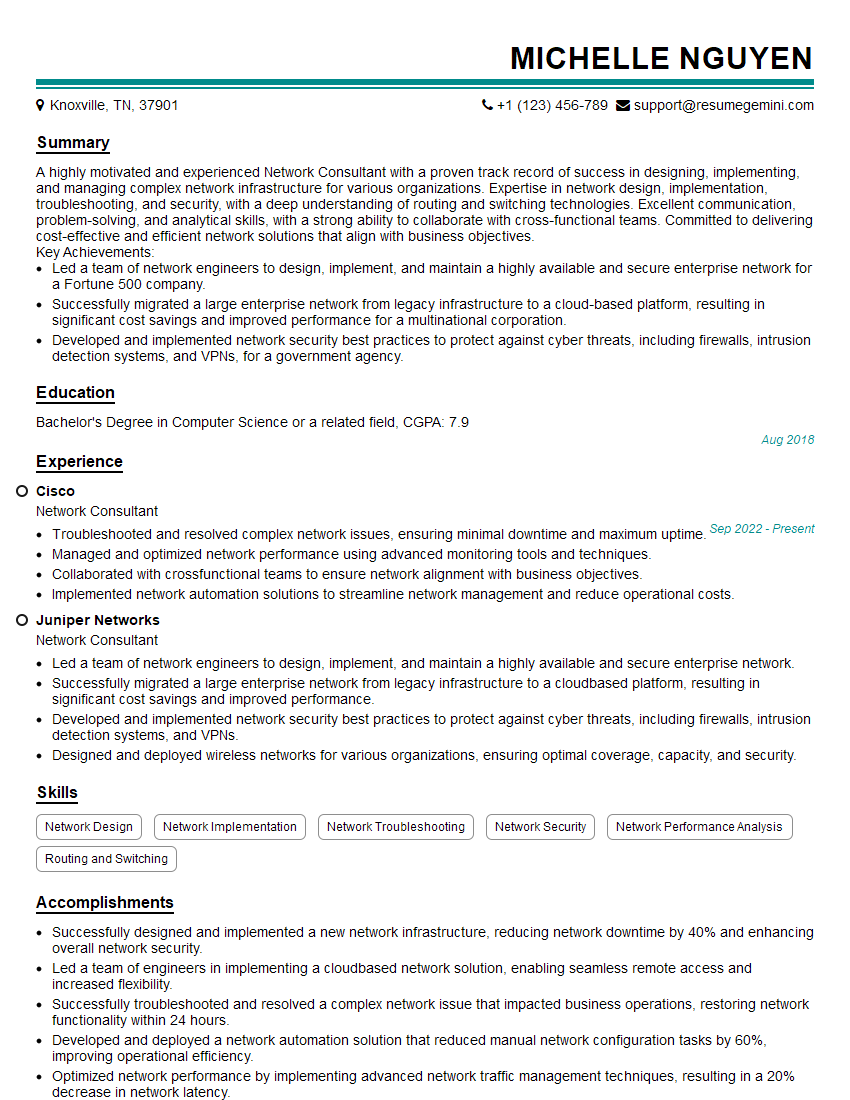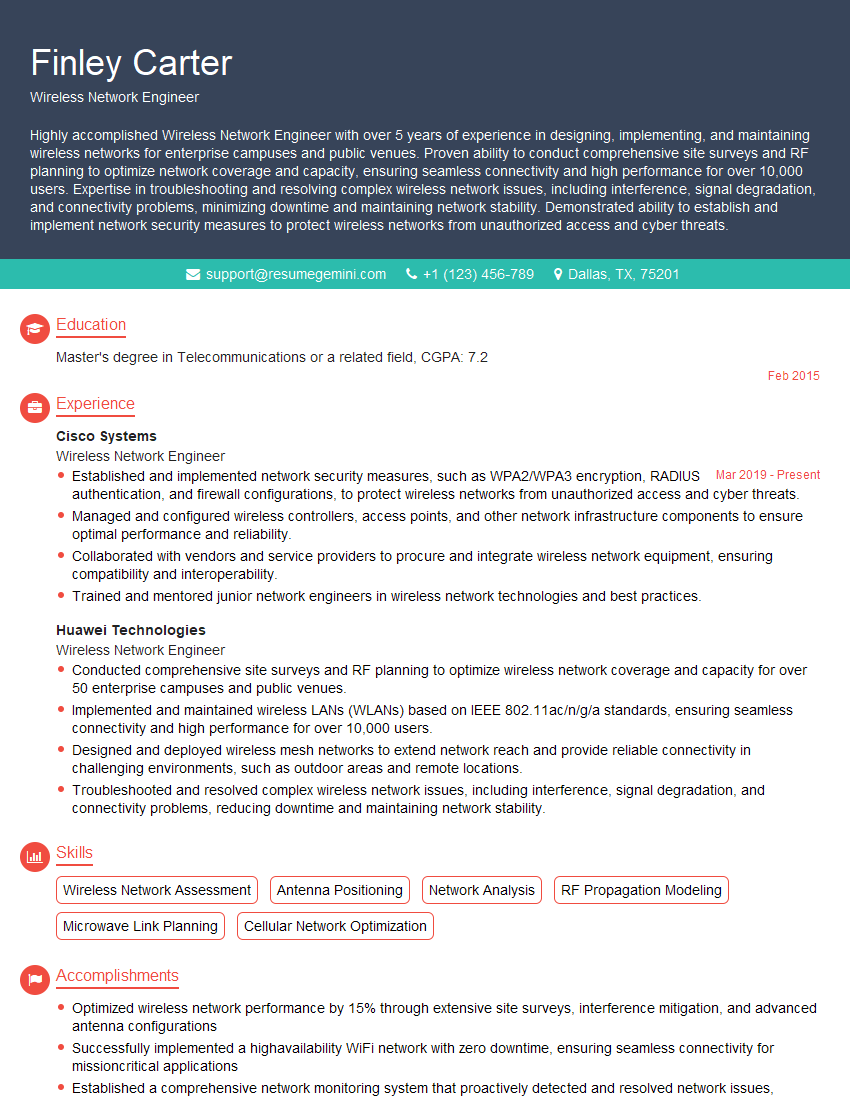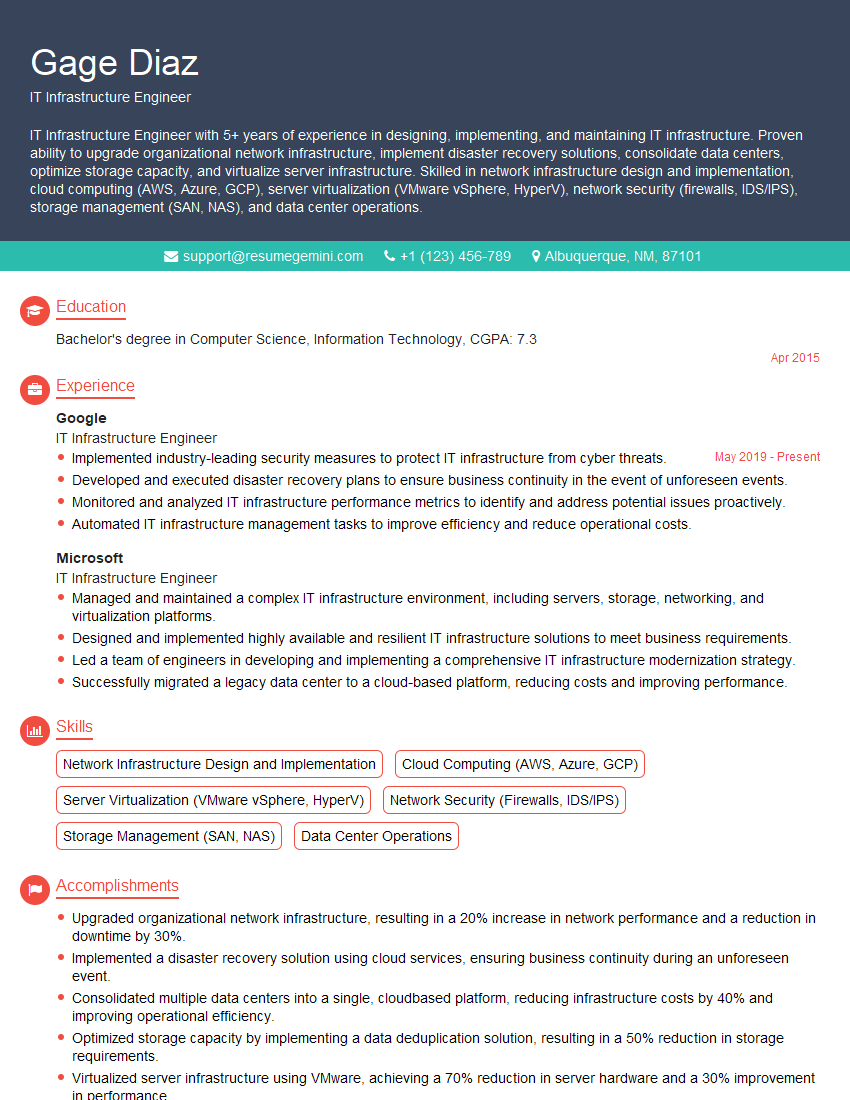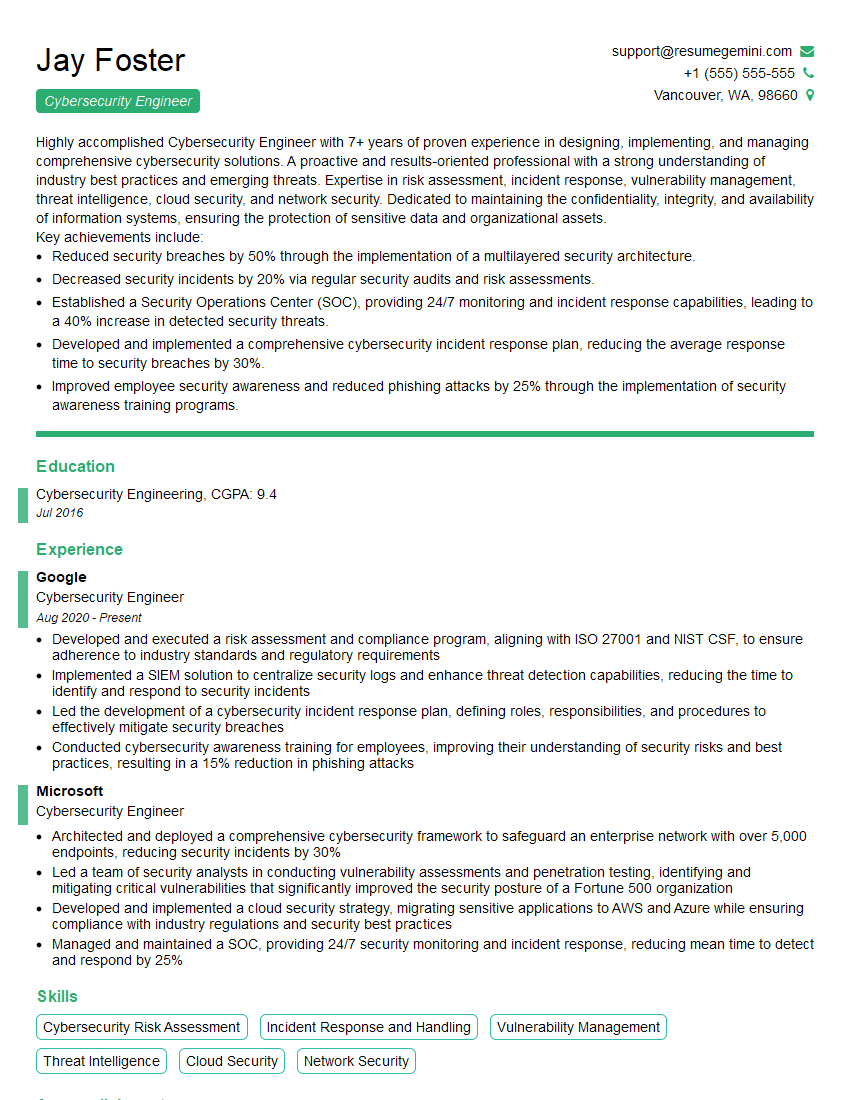Preparation is the key to success in any interview. In this post, we’ll explore crucial Understanding of network protocols and technologies interview questions and equip you with strategies to craft impactful answers. Whether you’re a beginner or a pro, these tips will elevate your preparation.
Questions Asked in Understanding of network protocols and technologies Interview
Q 1. Explain the difference between TCP and UDP.
TCP (Transmission Control Protocol) and UDP (User Datagram Protocol) are both fundamental protocols in the internet protocol suite (IP suite), but they differ significantly in how they handle data transmission. Think of it like sending a package: TCP is like sending a registered package requiring a signature upon delivery, ensuring reliable delivery, while UDP is like sending a postcard – it’s faster but there’s no guarantee it will arrive.
- TCP (Transmission Control Protocol): A connection-oriented protocol that provides reliable, ordered, and error-checked delivery of data. It establishes a connection between sender and receiver before transmitting data, ensuring all packets arrive in the correct sequence and without errors. This makes it ideal for applications requiring high reliability, such as web browsing (HTTP), email (SMTP), and file transfer (FTP).
- UDP (User Datagram Protocol): A connectionless protocol that offers faster data transmission but doesn’t guarantee delivery or order. It’s like sending a postcard – there’s no confirmation of receipt. UDP is suitable for applications where speed and low latency are crucial, even at the cost of reliability, such as online gaming (where a slightly delayed packet is better than no packet at all), streaming video (where minor packet loss is tolerable), and DNS lookups.
In essence, choose TCP when reliability is paramount, and UDP when speed and low latency are more important.
Q 2. What are the layers of the OSI model and their functions?
The OSI (Open Systems Interconnection) model is a conceptual framework that divides network communication into seven distinct layers. Each layer performs specific functions, enabling different devices to communicate regardless of their underlying hardware or software.
- Layer 1: Physical Layer: Deals with the physical transmission of data over a network medium (e.g., cables, wireless signals). Think of it as the actual wires and signals.
- Layer 2: Data Link Layer: Provides error-free data transfer between two directly connected nodes. It uses MAC addresses to identify devices and handles framing (packaging data into frames).
- Layer 3: Network Layer: Handles routing of data packets between networks using IP addresses. This is where routing protocols like RIP and OSPF operate.
- Layer 4: Transport Layer: Provides reliable data delivery and segmentation (breaking data into smaller packets). TCP and UDP reside in this layer.
- Layer 5: Session Layer: Manages connections between applications, including session establishment, management, and termination.
- Layer 6: Presentation Layer: Handles data formatting, encryption, and decryption, ensuring data is presented in a consistent format between different systems.
- Layer 7: Application Layer: Provides network services to applications, including HTTP, SMTP, and FTP. This is the layer you interact with when using a web browser or sending an email.
Imagine a factory assembly line: each layer represents a step in the process, ensuring the final product (data transmission) is completed correctly.
Q 3. Describe the three-way handshake in TCP.
The three-way handshake is the process TCP uses to establish a reliable connection between two devices. It’s a crucial step ensuring both parties are ready to communicate before sending any data. It works as follows:
- SYN (Synchronization): The initiating device sends a SYN packet to the destination, requesting a connection. This packet contains a sequence number.
- SYN-ACK (Synchronization-Acknowledgment): The destination device receives the SYN packet and responds with a SYN-ACK packet. This packet acknowledges the initial request and also contains a sequence number. It also requests a connection from the initial device.
- ACK (Acknowledgment): The initiating device receives the SYN-ACK packet and responds with an ACK packet, acknowledging the destination’s response and completing the handshake. The connection is now established, and data transfer can begin.
This three-step process prevents wasted resources by confirming both ends are ready before starting a potentially lengthy data exchange.
Q 4. What is subnetting and why is it used?
Subnetting is the process of dividing a larger network (IP address range) into smaller, logical subnetworks. Imagine a large apartment building; subnetting is like dividing the building into smaller apartments or floors, each with its own address.
Why is it used?
- Improved Network Organization: Subnetting helps organize large networks into smaller, more manageable units.
- Enhanced Security: By restricting access to specific subnets, organizations can enhance network security.
- Efficient Routing: Subnetting reduces the routing table size in routers, improving routing efficiency.
- Broadcast Domain Reduction: Limits the scope of broadcasts, minimizing network congestion.
For example, a company might subnet its network to separate departments (e.g., sales, marketing, IT), allowing for better control and security.
Q 5. Explain the concept of IP addressing (IPv4 and IPv6).
IP addressing is a system used to identify and locate devices on a network. Think of it like a house address – it tells you where a specific device is located.
- IPv4 (Internet Protocol version 4): Uses a 32-bit address represented as four decimal numbers separated by periods (e.g., 192.168.1.1). The limited address space (approximately 4.3 billion addresses) is a major limitation, leading to the development of IPv6.
- IPv6 (Internet Protocol version 6): Uses a 128-bit address represented as eight groups of four hexadecimal digits separated by colons (e.g., 2001:0db8:85a3:0000:0000:8a2e:0370:7334). Its significantly larger address space addresses the limitations of IPv4, supporting a vastly larger number of devices.
Both IPv4 and IPv6 addresses are crucial for routing packets across networks. IPv6 is slowly but surely replacing IPv4, as the latter’s address space becomes exhausted.
Q 6. What is DNS and how does it work?
DNS (Domain Name System) translates human-readable domain names (like google.com) into machine-readable IP addresses (like 172.217.160.142). Think of it as a phone book for the internet.
How it works:
When you type a domain name into your browser, your computer queries a DNS server. This server checks its cache (a local database of recently looked-up names). If the domain name isn’t found, it recursively queries other DNS servers (root, top-level domain (TLD), and authoritative) until it finds the IP address associated with the domain name. Once the IP address is found, the browser can connect to the server.
This process ensures that users can access websites using easily remembered names, rather than complex IP addresses.
Q 7. What is DHCP and its role in a network?
DHCP (Dynamic Host Configuration Protocol) automatically assigns IP addresses and other network configuration parameters (like subnet mask, default gateway, and DNS server addresses) to devices on a network. It simplifies network administration by eliminating the need to manually configure each device.
Role in a network:
- Automatic IP Address Assignment: DHCP servers automatically assign IP addresses to devices, preventing IP address conflicts.
- Centralized Network Configuration: Allows network administrators to manage network configuration parameters centrally, simplifying maintenance and updates.
- Improved Efficiency: Automates the process of configuring network settings, saving time and effort.
- IP Address Management: Provides mechanisms for tracking and managing the assignment of IP addresses.
Imagine a hotel assigning room keys (IP addresses) to guests automatically – DHCP provides a similar service on a network.
Q 8. Describe different network topologies (e.g., star, mesh, bus).
Network topologies describe the physical or logical layout of nodes (computers, printers, etc.) and connections in a network. Think of it as the network’s blueprint. Different topologies offer various advantages and disadvantages regarding performance, scalability, and cost.
- Star Topology: This is the most common topology. All nodes connect to a central hub or switch. If one node fails, it doesn’t affect the others. Imagine a star; each point is a device, and the center is the hub. It’s easy to manage and expand but relies heavily on the central device.
- Mesh Topology: Each node connects to multiple other nodes, providing redundancy. This is highly reliable because if one connection fails, others remain available. Think of a spiderweb; each intersection is a node, and the threads are connections. It’s robust but complex and expensive to implement.
- Bus Topology: All nodes connect to a single cable (the bus). Simple and inexpensive, but a single cable failure brings down the entire network. Imagine a main street (the bus) with houses (nodes) connected along it. A break in the street affects everyone.
- Ring Topology: Nodes are connected in a closed loop, data travels in one direction. Fairly simple, but a single node failure can disrupt the entire network. It’s less common now compared to star or mesh.
- Tree Topology: A hierarchical structure combining aspects of star and bus topologies. It’s often used in larger networks to segment and manage them efficiently. It resembles an upside-down tree; the root is the central device, and branches extend to other devices.
The choice of topology depends on factors like network size, budget, and required reliability.
Q 9. Explain the concept of routing protocols (e.g., RIP, OSPF, BGP).
Routing protocols are algorithms that determine the best path for data packets to travel across a network. They’re essential for directing traffic across large and complex networks, especially the internet. Different protocols suit different network sizes and complexities.
- RIP (Routing Information Protocol): A distance-vector protocol, meaning it shares routing information with neighboring routers based on hop count. It’s simple but has limitations, like a maximum hop count of 15 and slow convergence (takes time to adjust to changes).
- OSPF (Open Shortest Path First): A link-state protocol; each router builds a complete map of the network topology and calculates the shortest path using Dijkstra’s algorithm. It’s more scalable and efficient than RIP, with faster convergence. It’s used extensively in large enterprise networks.
- BGP (Border Gateway Protocol): The routing protocol of the internet. It’s used to exchange routing information between autonomous systems (AS), which are large networks like ISPs. It’s incredibly complex, capable of handling massive routing tables and supporting policies that control traffic flow.
Understanding routing protocols is crucial for network administrators to configure and troubleshoot routing issues. Choosing the right protocol depends on the network’s size, complexity, and performance requirements.
Q 10. What is a firewall and how does it protect a network?
A firewall is a network security system that monitors and controls incoming and outgoing network traffic based on predefined security rules. It acts like a gatekeeper, allowing only authorized traffic to pass through while blocking malicious or unwanted traffic.
Firewalls protect a network by:
- Filtering traffic: Based on source/destination IP addresses, ports, protocols, and other criteria.
- Preventing unauthorized access: Blocking access attempts from outside the network.
- Detecting and blocking malicious activity: Identifying and preventing intrusions like viruses and malware.
- Enforcing network security policies: Ensuring compliance with organizational security guidelines.
Firewalls can be hardware devices or software applications. They are crucial for protecting against cyber threats and ensuring network security.
For example, a firewall might block all incoming connections on port 23 (Telnet), which is known for being vulnerable to attacks. It might also block traffic from known malicious IP addresses.
Q 11. Explain the difference between NAT and PAT.
Both NAT (Network Address Translation) and PAT (Port Address Translation) are techniques used to conserve IP addresses. They allow multiple devices on a private network to share a single public IP address.
The key difference lies in how they handle this sharing:
- NAT: Maps a range of private IP addresses to a single public IP address, using different port numbers for each device. This means multiple devices can access the internet simultaneously, but the number of simultaneous connections is limited by the available ports.
- PAT (also known as NAT overload): Similar to NAT but uses only one public IP address and a single port number. It keeps track of individual sessions using different port numbers on the private side, allowing many more devices to share the single public IP address.
In essence, PAT is a more efficient and scalable form of NAT, allowing a much larger number of devices to share a single public IP address. Almost all home routers utilize PAT.
Q 12. What are VPNs and how do they work?
A VPN (Virtual Private Network) creates a secure, encrypted connection over a public network, like the internet. This secure tunnel protects your data from eavesdropping and interception. It’s like having a secret, encrypted phone line over the regular phone system.
VPNs work by:
- Encryption: All data transmitted through the VPN tunnel is encrypted, making it unreadable to unauthorized users.
- Tunneling: Data is encapsulated within a secure tunnel, protecting it as it travels over the public network.
- Authentication: Users must authenticate before accessing the VPN, ensuring only authorized users can connect.
VPNs are widely used for secure remote access to corporate networks, protecting online privacy when using public Wi-Fi, and bypassing geographic restrictions on content.
Q 13. What is VLAN and its purpose?
A VLAN (Virtual Local Area Network) is a logical grouping of devices on a network, regardless of their physical location. It’s like creating multiple smaller networks within a single physical network.
The purpose of a VLAN is to:
- Improve network security: By segmenting the network, VLANs limit the impact of security breaches. A compromised device in one VLAN won’t necessarily affect others.
- Enhance network performance: Reducing broadcast traffic and collisions by segmenting the network into smaller, more manageable units.
- Simplify network management: VLANs make it easier to manage and configure network settings for specific groups of devices.
- Control traffic flow: You can configure rules to control traffic flow between different VLANs, providing better control over network access.
For example, a company might create separate VLANs for employees, guests, and servers, each with its own security policies and access controls.
Q 14. Describe the concept of network security.
Network security encompasses all the measures taken to protect a network and its resources from unauthorized access, use, disclosure, disruption, modification, or destruction. It’s a multifaceted field that involves several layers of defense.
Key aspects of network security include:
- Confidentiality: Ensuring that only authorized users can access sensitive data.
- Integrity: Maintaining the accuracy and completeness of data, preventing unauthorized modification.
- Availability: Ensuring that network resources are accessible to authorized users when needed.
- Authentication: Verifying the identity of users and devices before granting access.
- Authorization: Controlling access to network resources based on user roles and permissions.
- Non-Repudiation: Ensuring that actions performed on the network can be traced back to a specific user or device.
Implementing network security requires a layered approach using various tools and techniques, such as firewalls, intrusion detection systems, VPNs, access control lists, and regular security audits. It’s an ongoing process, constantly adapting to evolving threats.
Q 15. Explain different types of network attacks.
Network attacks come in many forms, broadly categorized by their goal and method. Think of them as different ways someone might try to break into your house – some might try the front door, others a window, and some might even dig a tunnel underneath!
- Passive Attacks: These attacks involve eavesdropping or monitoring network traffic without altering it. An example is network sniffing, where attackers use tools to capture data packets traveling across the network. This information can reveal sensitive data like passwords or credit card numbers.
- Active Attacks: These attacks involve actively interfering with or modifying network traffic. Examples include:
- Denial-of-Service (DoS) attacks: Overwhelming a server or network with traffic, making it unavailable to legitimate users. Imagine a group of people blocking the entrance to a building, preventing anyone else from getting in.
- Distributed Denial-of-Service (DDoS) attacks: A more sophisticated version of DoS, using multiple compromised devices (a botnet) to launch the attack. Think of many groups of people, all coordinated, blocking the building entrance.
- Man-in-the-Middle (MitM) attacks: Intercepting communication between two parties to eavesdrop or modify data. This is like intercepting a letter sent between two people and changing the message.
- SQL Injection: Exploiting vulnerabilities in database applications to gain unauthorized access. This is akin to finding a secret key to unlock the building’s security system.
- Phishing Attacks: Deceiving users into revealing sensitive information like passwords or credit card details. This would be comparable to someone pretending to be a friend to get you to open the door.
Understanding these different attack types is crucial for implementing effective security measures.
Career Expert Tips:
- Ace those interviews! Prepare effectively by reviewing the Top 50 Most Common Interview Questions on ResumeGemini.
- Navigate your job search with confidence! Explore a wide range of Career Tips on ResumeGemini. Learn about common challenges and recommendations to overcome them.
- Craft the perfect resume! Master the Art of Resume Writing with ResumeGemini’s guide. Showcase your unique qualifications and achievements effectively.
- Don’t miss out on holiday savings! Build your dream resume with ResumeGemini’s ATS optimized templates.
Q 16. How do you troubleshoot network connectivity issues?
Troubleshooting network connectivity issues requires a systematic approach. Think of it like diagnosing a car problem – you need to check different parts to find the culprit. I usually follow these steps:
- Identify the Problem: What specifically isn’t working? Is it a single device, a group of devices, or the entire network? What error messages are you seeing? This is crucial in narrowing the field.
- Check the Obvious: Are cables plugged in correctly? Is the device powered on? Are there any physical obstructions? Often, the simplest issues are overlooked.
- Basic Connectivity Tests: Use tools like
pingto check network reachability,tracerouteortracertto identify path issues, andipconfigorifconfigto check IP addresses and network settings. These commands provide vital information about the communication pathways. - Examine Network Devices: Check routers, switches, and firewalls for errors or unusual activity. Look at their logs for clues. These devices are the backbone of your network – their performance directly impacts the network’s health.
- Check DNS Resolution: Can the device resolve hostnames to IP addresses? DNS is like a phonebook for the internet – if it’s not working, nothing can connect.
- Verify Firewall Rules: Are firewalls blocking necessary traffic? Firewalls are security guards – sometimes they’re too strict and hinder communication.
- Consult Network Documentation: This will give you valuable insights into the network’s architecture and configuration.
- Escalate if Necessary: If the problem persists, seek assistance from experienced network engineers or IT support.
In a recent incident, a client experienced slow internet speed. By meticulously following these steps, I identified that the issue was not with their internet provider, but rather with a faulty router. A simple reboot fixed the problem, highlighting the importance of starting with the basics.
Q 17. What is QoS (Quality of Service) and how is it implemented?
Quality of Service (QoS) is a set of technologies that prioritizes specific network traffic over others. Imagine a highway with different lanes – QoS is like having a fast lane for emergency vehicles, ensuring they reach their destination quickly. This is crucial in networks where some applications are more sensitive to latency (delay) and packet loss than others, like VoIP calls or video conferencing.
QoS is implemented using various techniques:
- Traffic Classification: Identifying network traffic based on its characteristics (e.g., protocol, port number, application). This is like identifying the type of vehicle on the highway.
- Traffic Policing: Limiting the bandwidth used by certain traffic flows. This is like controlling the speed of vehicles on the highway to prevent congestion.
- Traffic Shaping: Smoothing out traffic bursts to prevent congestion. This is like adjusting the flow of vehicles to maintain a steady pace.
- Queue Management: Prioritizing traffic based on its importance. This is like giving priority to emergency vehicles on the highway.
QoS mechanisms are often implemented in network routers and switches. They use various algorithms (like Weighted Fair Queuing (WFQ) or Class-Based Queuing (CBQ)) to manage traffic flows. Without QoS, your video conference could be constantly interrupted by high-bandwidth downloads, a situation easily avoided by prioritizing real-time traffic.
Q 18. Explain the concept of network monitoring and management.
Network monitoring and management are crucial for maintaining a healthy and efficient network. Think of it as regular check-ups for your network’s health. Monitoring involves constantly observing network performance and identifying potential problems, while management involves taking actions to rectify those problems and optimize the network’s efficiency.
Monitoring: This involves using tools and techniques to collect and analyze data about network devices and performance. This might include:
- Performance metrics: Bandwidth utilization, latency, packet loss, CPU and memory usage on network devices.
- Security events: Intrusion attempts, malware infections, unauthorized access attempts.
- Device status: Uptime, errors, and configurations of network devices.
Management: This encompasses the tasks involved in administering the network. This could include:
- Configuration management: Configuring network devices, setting up security policies, and managing user accounts.
- Troubleshooting and problem resolution: Identifying and fixing network issues.
- Capacity planning: Forecasting future needs and scaling resources accordingly.
- Security management: Implementing security policies and managing security tools.
Tools such as Nagios, Zabbix, and SolarWinds are frequently used for network monitoring and management. A well-managed network is proactive, predicting and preventing issues before they impact users or services.
Q 19. What are network performance metrics?
Network performance metrics are key indicators of a network’s health and efficiency. They’re like vital signs for your network, giving you insights into its performance. Key metrics include:
- Bandwidth Utilization: The amount of bandwidth being used compared to the total available bandwidth. High utilization can indicate congestion.
- Latency: The delay in data transmission between two points. High latency leads to slow response times.
- Packet Loss: The percentage of data packets lost during transmission. High packet loss indicates network instability.
- Jitter: Variations in latency, causing uneven data transmission. This significantly impacts real-time applications like VoIP.
- Throughput: The amount of data transmitted per unit of time. This measures the network’s data transfer efficiency.
- CPU and Memory Utilization: On network devices, high utilization can indicate overload and potential performance bottlenecks.
Monitoring these metrics helps identify potential bottlenecks, security breaches, and performance degradation. By regularly analyzing these metrics, potential issues can be identified and addressed before affecting users.
Q 20. What experience do you have with network security tools?
I have extensive experience with various network security tools, including:
- Intrusion Detection/Prevention Systems (IDS/IPS): Snort and Suricata are excellent examples; I’ve used them to monitor network traffic for malicious activity and proactively block threats. I’ve configured rule sets tailored to specific client needs.
- Firewalls: I’m proficient in configuring and managing both hardware and software firewalls (like pfSense, Cisco ASA, and Windows Firewall) to control network access and enhance security. This includes defining rules to allow and deny traffic based on various criteria.
- Network Monitoring Tools: Tools like Wireshark, tcpdump, and SolarWinds allow me to capture and analyze network traffic for troubleshooting and security analysis. I’ve used these tools to identify network vulnerabilities and security breaches.
- Security Information and Event Management (SIEM) systems: These systems, such as Splunk and QRadar, aggregate and analyze security logs from various sources. I’ve used them to correlate events, identify trends, and generate reports to improve overall network security posture.
- Vulnerability Scanners: Nessus and OpenVAS are familiar tools; I’ve used them to identify vulnerabilities in network devices and applications.
My experience extends to integrating and managing these tools within a comprehensive security architecture. In one project, I implemented a multi-layered security approach using a combination of firewalls, IDS/IPS, and SIEM systems, resulting in a significant reduction in security incidents.
Q 21. Describe your experience with specific network protocols (e.g., HTTP, HTTPS, FTP).
I have hands-on experience with several network protocols, including HTTP, HTTPS, and FTP. My understanding goes beyond simply knowing what they do; I can troubleshoot issues related to their functionality and security aspects.
- HTTP (Hypertext Transfer Protocol): This is the foundation of the web. I understand how HTTP requests and responses work, including headers, methods (GET, POST, PUT, DELETE), and status codes. I’ve worked on projects where optimizing HTTP requests significantly improved web application performance.
- HTTPS (Hypertext Transfer Protocol Secure): This is the secure version of HTTP, using SSL/TLS encryption to protect data in transit. I’m experienced in implementing and troubleshooting HTTPS, including certificate management and understanding various cipher suites. I’ve configured and secured multiple websites using HTTPS.
- FTP (File Transfer Protocol): This protocol is used for transferring files between a client and a server. I’m familiar with both active and passive modes of FTP, and I can troubleshoot connectivity issues related to firewall rules, port configurations, and authentication. I’ve used FTP for secure file transfer within organizations, implementing measures like SFTP (Secure FTP) for added security.
My knowledge of these protocols extends to their use in various applications and their security implications. For example, I understand the importance of using HTTPS to secure web applications and the security risks associated with using unencrypted FTP.
Q 22. How do you handle network outages?
Handling network outages requires a systematic approach combining proactive measures and reactive responses. My strategy begins with robust monitoring. I utilize tools that provide real-time visibility into network health, including packet loss, latency, and bandwidth utilization. This allows for early detection of potential issues. For instance, I’ve used Nagios and Zabbix extensively to monitor critical network devices and applications. When an outage occurs, my first step is to identify the root cause using diagnostic tools like traceroute and ping to pinpoint the location of the failure. This is followed by a triage process, prioritizing the restoration of critical services. This could involve switching to redundant systems, rerouting traffic, or contacting the relevant service providers. Finally, a post-mortem analysis is conducted to identify the underlying causes and implement preventative measures to avoid future occurrences. For example, a recent outage was traced to a faulty router; post-mortem analysis led to improved redundancy and stricter maintenance schedules.
Q 23. What is your experience with cloud networking?
My cloud networking experience spans several major providers, including AWS, Azure, and GCP. I’m proficient in configuring and managing virtual networks (VPCs), subnets, routing tables, and security groups. I have extensive hands-on experience with cloud-based firewalls, load balancers, and VPNs. A recent project involved migrating a client’s on-premise infrastructure to AWS. This involved designing a highly available and scalable architecture using multiple Availability Zones, implementing auto-scaling for critical applications, and establishing robust security measures. I’m also familiar with serverless computing and its implications for network design, understanding how the absence of traditional servers impacts routing and security.
Q 24. Explain your understanding of network virtualization.
Network virtualization allows you to abstract physical network resources, creating virtual networks on top of existing infrastructure. This enables greater flexibility, scalability, and efficiency. Think of it like having multiple virtual machines running on a single physical server—except instead of virtualizing computing resources, we’re virtualizing the network itself. Common examples include using VMware NSX, Cisco ACI, or Open vSwitch. These tools let you create virtual switches, routers, and firewalls, independent of the underlying physical hardware. This allows for easier management, faster provisioning of network services, and the ability to dynamically allocate network resources based on demand. The benefits include improved resource utilization, reduced capital expenditure, and increased agility in responding to changing business needs.
Q 25. Describe your experience with network automation tools.
My experience with network automation tools includes Ansible, Puppet, and Chef. I’ve used these tools to automate tasks such as configuring routers, switches, and firewalls, provisioning virtual networks, and monitoring network performance. Automation significantly reduces manual configuration errors, improves consistency, and accelerates deployment cycles. For example, I used Ansible to automate the deployment of a new branch office network, configuring all devices from a central location, ensuring consistency across the entire infrastructure. This approach drastically reduced deployment time and minimized the risk of human error.
Q 26. What is your familiarity with software-defined networking (SDN)?
Software-Defined Networking (SDN) is a paradigm shift in network management that decouples the network control plane from the data plane. Instead of relying on proprietary hardware with embedded control logic, SDN uses a centralized controller to manage the network’s behavior. This allows for more centralized management, programmability, and flexibility. Think of it as separating the ‘brain’ (control plane) from the ‘muscles’ (data plane). OpenFlow is a common protocol used in SDN. I have practical experience deploying and managing SDN solutions, leveraging OpenStack and other platforms to dynamically provision and manage network resources. This allows for greater agility and scalability, which is particularly important in dynamic cloud environments.
Q 27. Explain your experience with network capacity planning.
Network capacity planning involves forecasting future network needs and ensuring sufficient resources are available to meet those demands. It’s a critical process to avoid performance bottlenecks and ensure network scalability. This includes analyzing current network utilization, projecting future growth, and determining the necessary infrastructure upgrades. I typically use tools like SolarWinds or Cisco Prime to monitor current network performance and identify potential bottlenecks. Then, using historical data and projected growth rates, I create capacity models to predict future needs. This might involve upgrading existing hardware, adding new links, or implementing new technologies to handle increased bandwidth demands. For instance, in a recent project, I predicted a significant increase in bandwidth usage due to a new application rollout. My capacity planning prevented performance degradation and ensured a smooth transition.
Q 28. Describe a challenging networking problem you solved and how you approached it.
One challenging networking problem I solved involved intermittent network latency affecting a critical VoIP application. Initially, troubleshooting pointed to issues with the VoIP server, but extensive testing ruled that out. I systematically investigated the network infrastructure, using packet capture tools like Wireshark to analyze network traffic. I discovered that the latency was caused by high CPU utilization on a core switch due to a misconfigured spanning-tree protocol (STP). This was causing network loops and significantly impacting performance. My solution involved optimizing the STP configuration to eliminate the loops, which immediately resolved the latency issue. This case highlighted the importance of thorough network monitoring, advanced diagnostic tools, and a systematic approach to troubleshooting. Learning from this, I now incorporate more rigorous STP configuration checks into my standard operating procedures.
Key Topics to Learn for Understanding of Network Protocols and Technologies Interview
- TCP/IP Model and OSI Model: Understand the layers, their functions, and the relationship between these models. Be prepared to discuss the protocols operating at each layer.
- IP Addressing and Subnetting: Master IPv4 and IPv6 addressing schemes, including classful and classless addressing, subnetting calculations, and CIDR notation. Practice real-world scenarios involving network segmentation.
- Routing Protocols: Familiarize yourself with common routing protocols like RIP, OSPF, BGP, and their functionalities. Be ready to compare and contrast their strengths and weaknesses.
- Network Security Fundamentals: Understand basic security concepts like firewalls, VPNs, intrusion detection/prevention systems, and common network security threats. Discuss their roles in protecting network infrastructure.
- Wireless Networking (Wi-Fi): Gain a solid understanding of 802.11 standards, access points, wireless security protocols (WPA2/3), and common troubleshooting techniques.
- Network Troubleshooting: Develop your problem-solving skills by practicing common network troubleshooting methodologies. Be prepared to discuss tools and techniques for diagnosing network issues.
- Network Monitoring and Management: Understand the importance of network monitoring and the tools used to monitor network performance and identify potential problems. Discuss key performance indicators (KPIs).
- Cloud Networking Concepts: Develop a foundational understanding of cloud networking architectures, including virtual networks, load balancing, and cloud-based security solutions.
Next Steps
Mastering network protocols and technologies is crucial for career advancement in today’s interconnected world. A strong understanding of these concepts opens doors to exciting opportunities in networking, cybersecurity, cloud computing, and many other technology fields. To significantly boost your job prospects, creating an ATS-friendly resume is essential. ResumeGemini is a trusted resource to help you build a professional and effective resume that highlights your skills and experience. ResumeGemini provides examples of resumes tailored to network professionals, giving you a head start in crafting a compelling application that stands out from the competition.
Explore more articles
Users Rating of Our Blogs
Share Your Experience
We value your feedback! Please rate our content and share your thoughts (optional).
What Readers Say About Our Blog
Hello,
We found issues with your domain’s email setup that may be sending your messages to spam or blocking them completely. InboxShield Mini shows you how to fix it in minutes — no tech skills required.
Scan your domain now for details: https://inboxshield-mini.com/
— Adam @ InboxShield Mini
Reply STOP to unsubscribe
Hi, are you owner of interviewgemini.com? What if I told you I could help you find extra time in your schedule, reconnect with leads you didn’t even realize you missed, and bring in more “I want to work with you” conversations, without increasing your ad spend or hiring a full-time employee?
All with a flexible, budget-friendly service that could easily pay for itself. Sounds good?
Would it be nice to jump on a quick 10-minute call so I can show you exactly how we make this work?
Best,
Hapei
Marketing Director
Hey, I know you’re the owner of interviewgemini.com. I’ll be quick.
Fundraising for your business is tough and time-consuming. We make it easier by guaranteeing two private investor meetings each month, for six months. No demos, no pitch events – just direct introductions to active investors matched to your startup.
If youR17;re raising, this could help you build real momentum. Want me to send more info?
Hi, I represent an SEO company that specialises in getting you AI citations and higher rankings on Google. I’d like to offer you a 100% free SEO audit for your website. Would you be interested?
Hi, I represent an SEO company that specialises in getting you AI citations and higher rankings on Google. I’d like to offer you a 100% free SEO audit for your website. Would you be interested?
good




